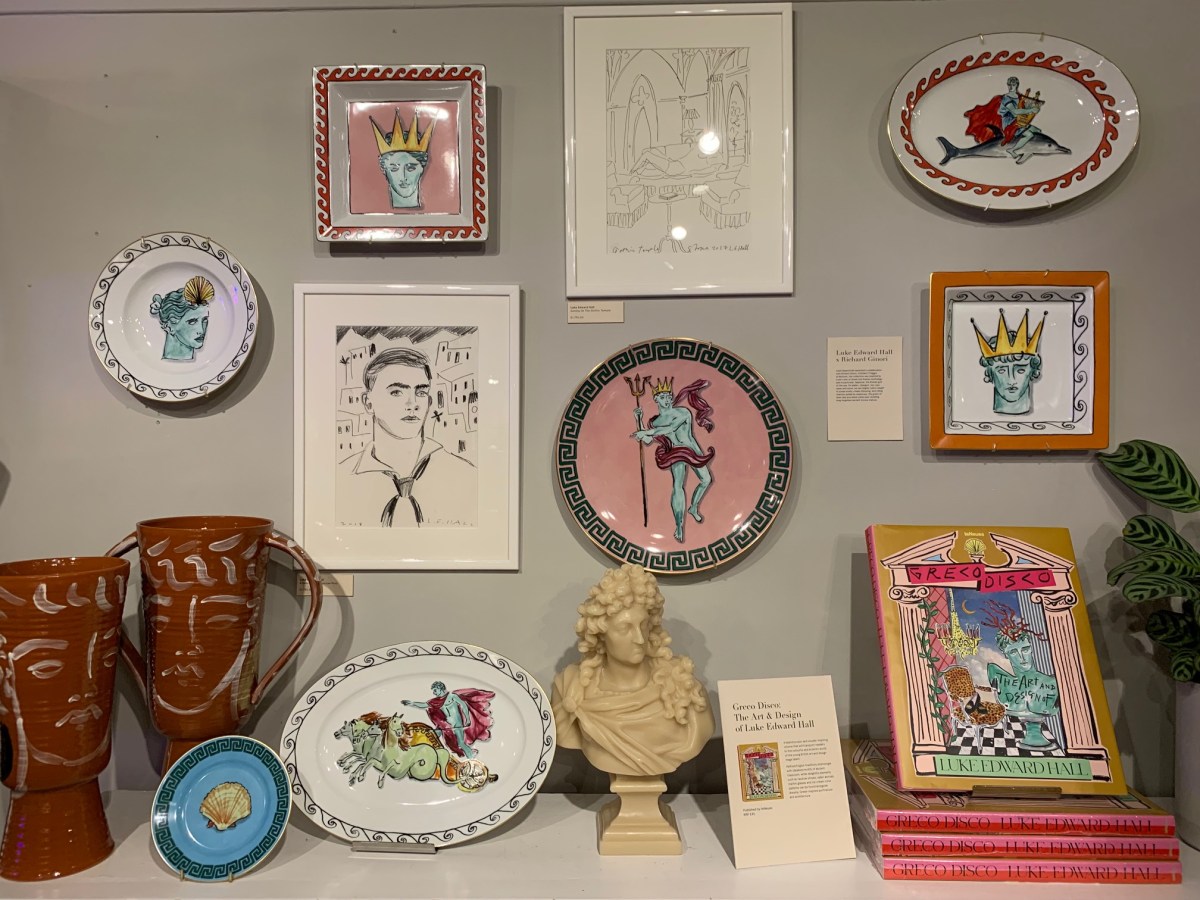Autumn 2019 Exhibition round up
The artist Luke Edward Hall’s star is again in the ascendancy with a stunning exhibition in the London Liberty Galleries. The London based artist who specialises in the applied arts has produced a new coffee table book and a range of classically inspired pieces on sale for Christmas.
Hall’s line is mannered and expressive with a light touched naïveté. The colouring though simple is full bodied. He expresses movement and volume through a few brush strokes. He draws on the classical for his inspiration, luxuriating in the stately orders and the eroticism of its male bodies.
Yet he lacks the creative spark of other artists and an understanding of form understood by the very best technicians. For all his exquisite taste, his work resembles too closely the work of Jean Cocteau (whose murals in the Church of the Notre Dame de France, a five minute work a way in China Town, are worth a visit) or even more daringly Picasso, whose ceramics aimed at marrying high art with the accessiblity of commercial production. Picasso was a genius. Beware following too closely in the wake of a mighty ship.
At the other end of the scale, Hall cannot compare to a producer like Josiah Wedgewood who spent decades perfecting a single piece, the Portland Vase, and who understood the marriage between form and function. Hall’s decorations feel like applications. In contrast to Wedgewood, his pieces are slapdash and feel like they are done for a quick buck.
We may be forgiving to Hall, and call his understanding of classical art instinctual but at times they feel calculated. The classical is used as a short cut to integrity. It is not interrogated or challenged. There is no examination of what made the “classical” in antiquity or through its long history of reception, especially at key moments like the Italian Renaissance or the British Greek revival.
Hall’s Coffee table book is a heady mix of classical motifs and youths reclining in fashion ware. It’s essentially a beefed up collection of his instagram feed, but designed to feel like a retrospective of his three years as a professional artist. Even given our criticisms, we might hope he lasts longer than this.
Some of his most important work is not on show. This would be his articles on interior design for the Financial Times. Hall has taken on the Scylla and Charybdis of Scandinavian Minimalist Brutalism on the one hand and the Oliver Bonas tat on the other. He has reintroduced the joy of maximalism to a generation of po faced millenials. There are already calls to force the National Trust to buy his flat in Camden and preserve it for the nation.
☆☆★★★
Bauhaus at RIBA
If you are looking for an understanding of how high art can work within architectural settings head to RIBA for two well designed exhibitions on Bauhaus and László Moholy-Nagy. The Bauhaus exhibition extends the structural columns, creating vitrines into which visitors must place their heads: an unsettling experience that reflects the threat of death under which these practitioners lived (the experience is uncannily like putting your head into a guillotine). The need to proactively look at the objects on display embodies the historical experience of discovery, the sense of a tradition that is at once both removed from the English vernacular and an essential part of it. Museum UX at its most uncompromising but brilliant. Presumably the designers also considered accessibility.
★★★★★
House Voltaire
If you are looking for an understanding of how contemporary art can marry the commercial to become accessible, then head to Cork Street where Studio Voltiare have opened an art shop for everyone.
Bronstein’s Festival Cart in the Egyptian style is a stand out piece. As is Charlotte Prodger’s Bats, Honeycomb, Nefertiti a risograph from 2014 which is a powerful meditation on ancient art and how its reproduction in the modern age gives rise to new forms which bring into question the structures of order on which classicism is built. Prodger who won the 2018 Turner Prize understands this on an instinctual, intellectual and artistic level.
Aaron Angell (of Grotwork fame) draws on the radical tradition of late twentieth century ceramic art to create pieces that howl with a manic energy contained in the stillness of clay, the agonised brushstrokes and delicate glazing.
★★★★★
Summary
Some good shows this autumn. If you are looking to beautify the house with impactful and beautiful pieces, try Linder’s flatware.







